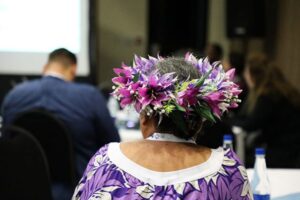
Asia-Pacific, Climate Action, Climate Change, Climate Change Finance, Climate Change Justice, Conferences, COP28, COP29, Development & Aid, Editors’ Choice, Environment, Featured, Latin America & the Caribbean, PACIFIC COMMUNITY, Pacific Community Climate Wire, Small Island Developing States, Sustainable Development Goals, TerraViva United Nations

Buoyed by the collaboration and agenda established in their SIDS4 conference in May, small island developing states are preparing for COP29 with a focus on climate finance and collaboration. IPS spoke with an official from Saint Lucia about that nation’s climate action, preparation for COP29 and the importance of a united SIDS’ voice in negotiations.

Section of Castries, Saint Lucia. Through ambitious NDCs, SIDS like Saint Lucia are hoping to shore up resilience and protect their economies and infrastructure. Access to adequate climate financing remains crucial to these efforts. Credit: Alison Kentish/IPS
– Small Island Developing States (SIDS) are experiencing the most severe impacts of climate change. When leaders of those islands met in Antigua and Barbuda in May, they let the world know that achieving climate justice hinges on comprehensive climate finance.
As they prepare for the 2024 United Nations climate change conference (COP29) in Baku, Azerbaijan, Saint Lucia is prioritizing this issue, strengthening alliances with other SIDS, and seeking critical funding for adaptation and mitigation projects. With the recent enactment of its Climate Change Act of 2024, the island nation recognizes that securing climate finance is vital for safeguarding its future.
“This year’s COP has been dubbed the ‘Finance COP’,” Maya Sifflet, a Sustainable Development and Environment Officer for Saint Lucia told IPS. “The focus is to get the finance we need to mobilize and implement the ambitious climate action we’ve committed to.”
Saint Lucia, like many other SIDS, faces significant challenges in adapting to the impacts of climate change. Rising sea levels, more intense storms and shifting weather patterns are already threatening its economy and infrastructure. Sifflet explained that Saint Lucia has developed a comprehensive National Adaptation Plan (NAP), which integrates climate action into national development strategies. However, without adequate funding, even the most well-crafted plans risk falling short.
“Every year, countries submit their nationally determined contributions (NDCs), outlining the climate action they’re taking. We are encouraged to make them as ambitious as possible, stating what climate action we are taking. Our NDCs now capture not only our mitigation efforts, but our adaptation efforts as well,” Sifflet said.
Finance is crucial to those plans.
“We need to ensure our sectors are more resilient—agriculture, tourism, fisheries. Each sector was encouraged to assess its risk, assess vulnerabilities and explore what actions can be taken to build resilience. We have therefore developed several sectoral adaptation strategies and action plans.”
Saint Lucia has also developed a set of bankable project concepts, which aim to make the nation “finance-ready” when global funds become available. These initiatives are part of a broader effort to position the country to receive climate funding, whether through bilateral agreements or international mechanisms.
Sifflet emphasized that collective action through umbrella groups like the Alliance of Small Island States (AOSIS) is crucial to Saint Lucia’s success at COP29. “We negotiate in blocs. Our strength is in numbers,” she said. “Through AOSIS, we exchange knowledge, share experiences, and amplify each other’s voices in the negotiations. It’s a big arena, it’s very contentious and you need that collective presence to have power.”
One of the key areas Saint Lucia and AOSIS members will focus on during COP29 is the operationalization of the Loss and Damage Fund, which was a breakthrough agreement during COP27. The fund is designed to provide financial assistance to vulnerable countries for losses and damages resulting from climate change impacts that cannot be mitigated or adapted to.
“Operationalizing the Loss and Damage Fund would be a major success at COP29,” Sifflet noted. “It’s something SIDS have lobbied for over many years. This fund signifies that the global community is ready to put money where their mouth is.”
Saint Lucia, in anticipation of the fund’s formalization, has already conducted a Loss and Damage Needs-Based Assessment to ensure it is prepared to access financing once it becomes available.
“As vulnerable countries, we bear the brunt of climate change, often being forced to hit the reset button after every extreme weather event,” Sifflet added. “And it’s not just about economic losses—our cultural assets, things that can’t be quantified, are at risk. There is so much at stake for us as small islands,” she told IPS.
Sifflet concluded that while Saint Lucia’s preparation for COP29 has been extensive, the real measure of success will be securing the finance and global commitments needed to ensure the survival and prosperity of small islands in the face of climate change.
This week, the COP29 Presidency unveiled a group of programmes to propel global climate action. In a letter to all parties, President-Designate Mukhtar Babayev said it include the Baku Initiative on Climate Finance, Investment and Trade, noting that “climate finance, as a critical enabler of climate action, is a centrepiece of the COP29 Presidency’s vision.”
This year’s COP is expected to be a competitive negotiations stage for global climate change funding. Small island developing states will be looking to the large economies and major emitters of greenhouse gases to give the financial support needed for adaptation and mitigation measures to cope with a crisis that they did little to create. The stakes for Saint Lucia, and other SIDS, are high.
IPS UN Bureau Report

















